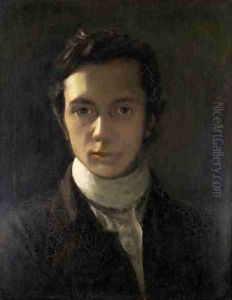William Hazlitt Paintings
William Hazlitt was an English writer, drama and literary critic, painter, social commentator, and philosopher. He was born on April 10, 1778, in Maidstone, Kent, England, to a Unitarian minister. Despite being known predominantly for his writings, Hazlitt also showed a keen interest in the visual arts. He studied for a short period at the Royal Academy, where his inclination towards painting began to emerge. Although he never achieved significant acclaim as a painter, he did produce several portraits and conversation pieces, which today provide an intriguing glimpse into his artistic abilities.
Hazlitt's true impact, however, comes from his extraordinary body of written work. As an essayist, he is best known for his humanistic essays and literary criticism. His writings are characterized by the clarity and eloquence of his prose and his ability to bring forth the essence of his subjects with remarkable insight and empathy. His most famous works include 'Characters of Shakespear's Plays' (1817), 'A View of the English Stage' (1818), 'Table Talk' (1821-22), and 'The Plain Speaker' (1826). His essays covered a wide range of topics, from art criticism to political discourse, and they continue to be celebrated for their critical precision and the richness of their language.
Hazlitt's personal life was marked by financial instability and often tumultuous relationships. His first marriage, to Sarah Stoddart, ended in divorce, and his second marriage, to a widow named Bridget McShane, was also troubled. Despite these personal challenges, Hazlitt remained a prolific writer throughout his life. His works are often autobiographical, offering a window into his worldviews and experiences. He was a passionate advocate for individual liberty and the rights of man, themes that are prevalent throughout his essays.
William Hazlitt died on September 18, 1830, in London, leaving behind a lasting legacy as one of the greatest critics and essayists of the English language. His work has influenced countless writers and critics and continues to be studied and admired for its critical acumen, engaging style, and deep humanism. Although not as well-remembered for his painting, Hazlitt's artistic pursuits reflect the breadth of his interest in the arts and his commitment to a life of intellectual engagement.
